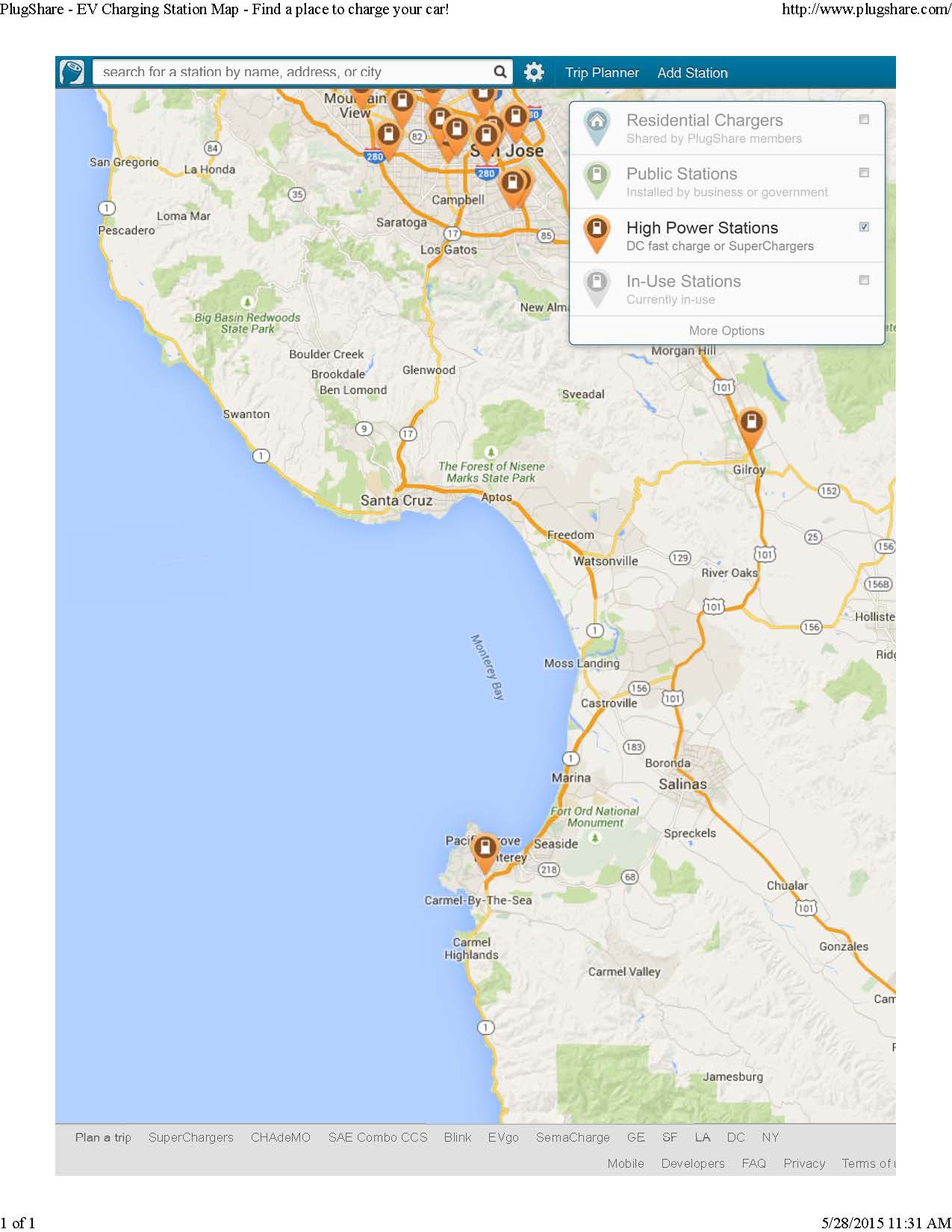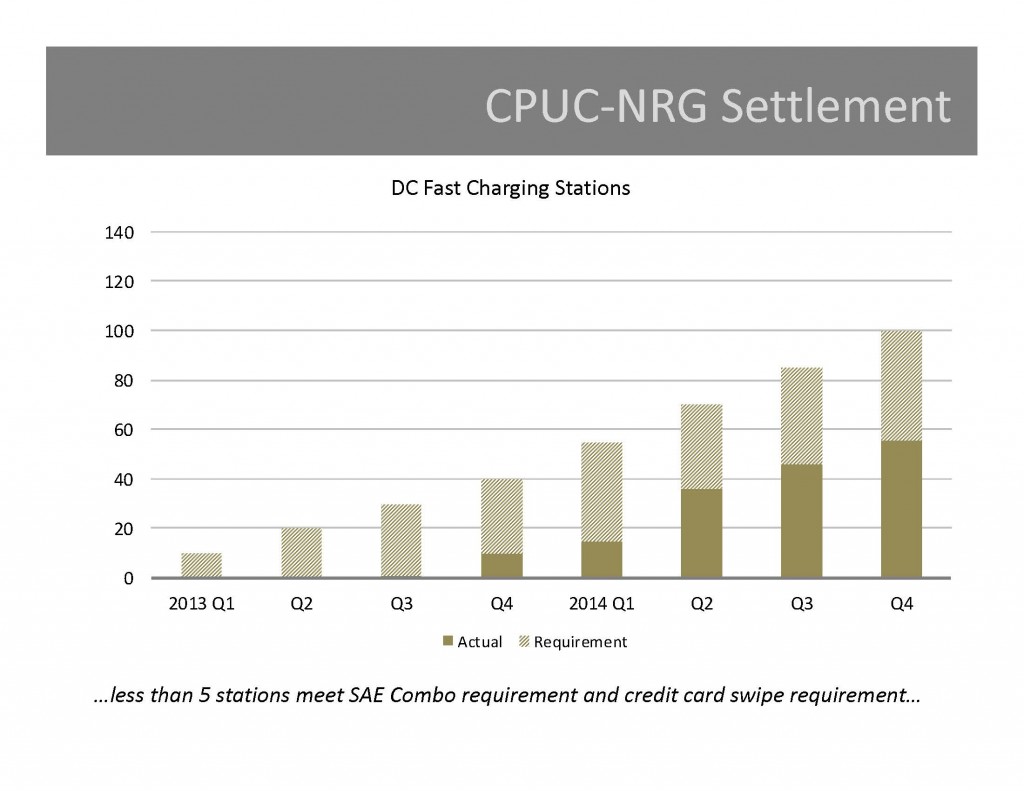
Like the proverbial Betamax vs. VHS technology competition of the 1980s, EV fast charging has been caught up in a wasteful turf war involving three different formats, basically boiling down to Japan versus Europe/North America vs. Tesla. But now we suddenly have a winner, as first Ford and then General Motors and startup Rivian have all pledged in the past few weeks to adopt the Tesla charging standard in their vehicles starting next year, with adapters available for consumers this year.
It couldn’t happen soon enough. The differing charging formats means EV drivers are limited where they can get fast charging or have to carry adapters, while non-Tesla charging stations had to have multiple plugs available for different formats.
The other problem is that non-Tesla chargers are basically awful. They’re unreliable, clunky and often with low power. While legacy automakers dithered and refused to invest in a network of chargers, Tesla instead built a user-friendly, ubiquitous network. The company is now poised to reap the economic benefits, from its position as a dominant market leader in vehicle sales.
One of the big questions now is what happens to all the soon-to-be-obsolete chargers out there? Companies like EVgo and Electrify America have built thousands of fast-charger stations with formats that are now zombie technology. Worse, the public has invested significantly in these stations, with EVgo a creation of a $100 million legal settlement from the California energy crisis circa 2000, while Electrify America was funded with dollars from the Volkswagen “dieselgate” emissions cheating settlement, to the tune of almost $1 billion in California alone.
All will not be lost, as the stations can be retrofitted in some cases. The wiring is sometimes the hard part, so charger replacement by itself may not be too expensive. But in some cases, retrofits may be uneconomical. And ultimately, these companies are likely to go out of business, unless they can get access to Tesla’s intellectual property to build their own versions of a Tesla SuperCharger.
If not, Tesla will have a monopoly on charging stations, which will create its own long-term problems. But for now, the charging format wars have ended, in favor of a far superior product.
That’s something that both EV advocates and drivers can finally celebrate.
In the wake of the VW emissions-cheating scandal, the proposed settlement involves allowing VW to invest heavily in electric vehicle infrastructure, per E&E News [paywall]:
Under the settlement, Volkswagen AG will have to invest $2 billion over 10 years to increase access to EVs by supporting charging infrastructure and public outreach, with $800 million allotted to California. ChargePoint Inc. and California lawmakers including U.S. Rep. Anna Eshoo (D) and state Senate President Pro Tem Kevin de León (D) argued that the special fund lacks oversight and risks stifling the EV-charging industry.
California has some experience with these kinds of settlements, and it’s not good. As I’ve written before, the state settled with NRG’s parent electricity company for defrauding California ratepayers during the phony electricity crisis and rolling blackouts at the turn of this century.
As “punishment,” NRG got to spend $100 million on a new line of business: EV charging infrastructure. The settlement terms though have never been followed, and the California Public Utilities Commission took over a year just to hire an auditor to find out what’s going wrong. The audit hasn’t even begun yet, a year-and-a-half later.
So if regulators and the court go down this path with VW, let’s hope they put real teeth into monitoring and enforcement of the settlement terms. Otherwise this deal won’t end up so well for taxpayers and the defrauded.
California regulators have been busy approving “pilot” projects for utilities to start paying for EV charging infrastructure, at significant ratepayer expense. Last week, they approved PG&E’s controversial plan, which had the blessing of environmentalists and unions, while ratepayer advocates and the San Francisco Chronicle cried foul. It will target a deployment of 7,500 level 2 charging ports and 100 DC fast-charging ports.
And with the passage of SB 350 last year, utilities will be entering the EV charging game big time in the coming years. These pilots are just the initial salvo.
But the state had already required $100 million in EV charging investment from NRG/eVgo as part of a legal settlement in 2012. That company has been badly behind schedule on getting these stations up and running, leading regulators to call for an audit over a year ago.
The status of the audit? Well, I emailed the California Public Utilities Commission recently to find out, and they told me they just hired an auditor to do this work at the end of February. No explanation was offered as to why that took the agency a whole year to do so.
So while regulators are busy ushering utilities into the EV charging world, they’re asleep at the wheel monitoring the state’s $100 million investment already in the works. Not a good sign as utilities start spending big ratepayer bucks on EV charging.
This time-lapse video shows the progress in the past 2.5 years:
Compare that progress to eVgo, which is struggling to spend $100 million in settlement money on a variety of charging infrastructure deployment in California. Progress is so bad that the California Public Utilities Commission is now hiring an auditor to find out what’s going on. I’ll eagerly await that report.
Okay, this is a subjective rant. But it points to a larger failing in California’s electric vehicle infrastructure. This past Memorial Day weekend, I was set for a short vacation in Monterey, a significant regional destination about 70 miles from San Jose, south of the Bay Area.
I wanted to drive my Nissan LEAF, which gets about 80 miles range on flat elevation. From the East Bay where I live, it would require one fast-charge (80% battery recharge in about 20 minutes) just south of San Jose, which is about 60 miles from my home.
But in looking at the charging map, there are no fast chargers south of San Jose — unless you’re lucky enough to drive a Tesla of course, then you can charge in Gilroy. The fast chargers in San Jose would leave me with a white-knuckle drive to Monterey, given the elevation and distance.
Here’s a screenshot of the Plugshare.com map, with a Tesla fast charger in Gilroy but otherwise a no-man’s land of fast-chargers until you get to Carmel (about 10 miles further south of Monterey):
Why haven’t EV charging companies fixed this missing link? This route is exactly the situation for a series of fast-chargers, given that you have a major regional destination about 70 miles from a densely populated urban area.
This is why California policy makers are now auditing eVgo, the company that benefited from a $100 million settlement back in 2012 to deploy a network of chargers around the state. I wrote about it recently, but the company’s progress has been dismal. EVgo has been focusing on money-making fast-charging sites in urban areas, rather than the Tesla approach of building a convenient network statewide to get people like me from a major urban area to a vacation destination.
I hope the audit and ensuing action means that critical corridors like the one to Monterey get the fast-chargers they need to encourage people to buy EVs. Otherwise, even with range improvements, EVs will largely be doomed to commuter status for the foreseeable future, requiring people to buy gas cars for destination trips.
California is not getting it done when it comes to public charging infrastructure for electric vehicles. The stations are too few and far between, unreliable, and crowded. Brett Hauser, CEO of charging company Greenlots, described the overall problem (for non-Tesla drivers) at a recent California Energy Commission hearing, citing a PlugShare.com survey of EV drivers:
[I]n terms of driver satisfaction or dissatisfaction is the confidence [for EV drivers] in knowing that wherever they’re going, that if they’re trying to plan a trip that is of significant range that there is a great risk that that charge station, when they get there, is either not going to be available or, in fact, will be broken. I think, as a matter of fact, when they surveyed, I think it was about 547 drivers, those drivers that were Tesla drivers, 93 percent of those drivers actually had confidence that that charge station would be up. But all others it was down to 33 percent. Okay, I mean and that’s on all of us.
At the same Energy Commission hearing, many of the major players on EV infrastructure in the state spoke about the lack of progress to date, particularly with respect to publicly funded infrastructure. The transcript is available on-line [PDF].
Perhaps the most striking revelation from the hearing was eVgo’s inability even to come close to meeting the $100 million settlement terms on EV infrastructure spending [PDF] that it agreed to in 2012. NRG, eVgo’s parent company, had reached the terms with the state for the devious corporate behavior of one of its acquired subsidiaries back in the rolling blackout days circa 2000. These charts from the California Public Utilities Commission presentation [PDF] sum up the dismal state of eVgo progress:
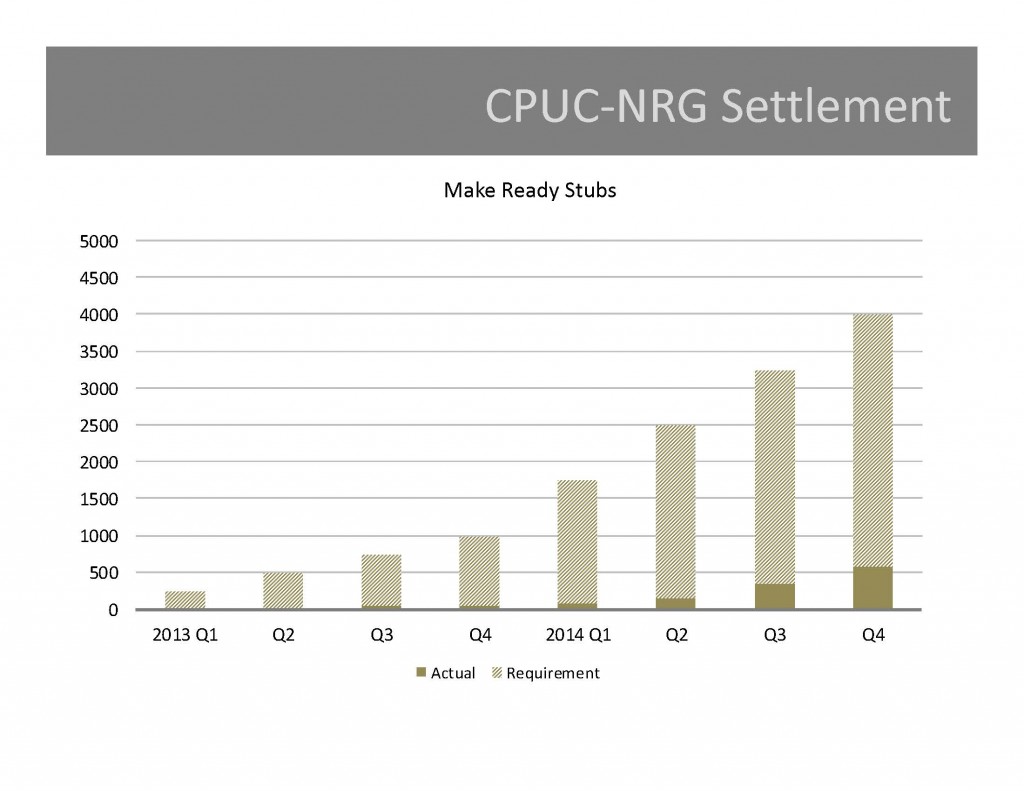
It’s gotten so bad that the agency is now hiring an auditor to determine the causes of the non-compliance.
So what gives? NRG/eVgo representative Terry O’Day explained that the siting process for these charging facilities has been extraordinarily complicated. He described it as a multi-step process that typically takes 9-12 months:
And the steps along the way include host approvals for retail tenants and for landlords. It includes utility interconnection. It includes permitting.
He also described some critical gaps in the system, such as in West Los Angeles and San Francisco’s peninsula and East Bay where there’s an “older building stock” that makes siting more difficult. He also noted a big gap in rural Northern California around the faux state of Jefferson. Safety, lighting, and handicap accessibility are all big factors:
You know, we need to plan these stations to consider this edge case of a single mom, with two kids, at 11:00 at night, in rural Northern California, when it’s raining. And that station better work because we took — we convinced that driver to come out to that station in the middle of a rural community. That means it also has to be available.
But even in overcoming these challenges, a larger problem emerges: the lack of a viable business model for private sector ownership of the stations. As Charlie Botsford, project manager for the West Coast Electric Highway, described:
One of our stations took two years to develop. It was on Forest Service property. Don’t ever, whatever you do, put something on government property, especially Forest Service. That was Mt. Hood Ski Resort, so it was really, really difficult. So, I can give you all kinds of horror stories, war stories about siting fast chargers, and getting into lease agreements. A lot of it has to do with why, you know, what’s the motivation for putting a fast charger at a particular site. And, you know, because the business model is — to say that it’s weak is an understatement. It’s even weaker, by the way, for level 2. But for DC fast chargers, it’s a pretty weak business model.
Actually, the best business model that I’ve seen so far is Tesla and they do it for completely different, self-serving reason, purely for the convenience of their drivers. Wow, what an idea.
Complicating matters, the major automakers plan to introduce cheaper 200-mile range, all-battery electric vehicles in the next two years. Drivers’ charging needs are therefore about to rapidly change, as they’ll need more local overnight charging opportunities if they can’t charge at home or work and more interstate-based charging sites between major cities.
So it may be time to rethink how the public supports charging infrastructure in general. Tony Williams, R&D manager for Quick Charge Power LLC, drafted an open proposal to the Energy Commission:
I propose that our state fund a logical California West Coast Electric Highway system comprised of 40 multi-charger (2 minimum) “Plazas” that are powered by onsite batteries, and the batteries are replenished with solar, wind power where applicable, and “single” phase sub-20kW grid power to mitigate or eliminate “demand charges”. These sites would cost approximately $250,000 per site and be placed at 60-100 miles apart along the major corridors that already have freeways:
1) Los Angeles to Sacramento, via 5 and 99
2) Los Angeles to Las Vegas, via 15
3) Los Angeles to Phoenix, via 10
4) Los Angeles to San Francisco via 101
5) San Francisco to Reno via 80
6) San Francisco to Oregon via 101
7) Sacramento to Oregon via 99 and 5
8) San Diego to Yuma via 8These are the logical routes the Californians actually drive to already. With numerous 100-200 mile electric cars on the horizon from major auto manufacturers like General Motors and Nissan, and also premium auto makers like Tesla and Jaguar, these routes must be planned for the near future, but made capable with existing cars that have sub-100 miles ranges. For those cars, I recommend placing small 20kW DC chargers in between each Plaza site, which will not need batteries or infrastructure to eliminate demand charges.
Williams argues that the investment would be relatively small, or “just half the amount of money devoted to hydrogen cars for just one year (just $10 million) by our state,” with an additional $2.5 million to fund 50 additional low powered sites at $50,000 per site.
Of course, this plan won’t necessarily help condo and apartment dwellers who lack home charging options. But that could be addressed in part through new technologies, like chargers on streetlights and chargers that don’t need to be hard-wired but can roam around a parking lot. Plus greater utility involvement in funding urban chargers. Overall, if you combine this interstate charging plaza idea with improved local deployment, then California would be on its way to solving many of the EV infrastructure challenges.
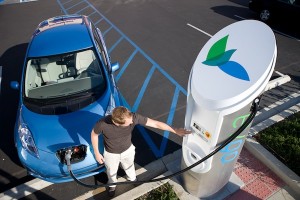 Good news for those who can’t afford a Tesla but want to or currently drive a battery electric:
Good news for those who can’t afford a Tesla but want to or currently drive a battery electric:
The [charging] stations will be built and operated by ChargePoint, the nation’s largest charging provider, which already has about 20,000 stations in place. Prices vary, but about $.50 per kilowatt-hour is standard, which means “filling” the e-Golf will run you 12 bucks if you’ve managed to completely drain the 24 kwHr pack.
In the east, the network will let drivers go from Boston to Washington on I-95. Out west, you’ll be able to drive from Portland, Oregon, to San Diego. The stations will offer 50-kW fast chargers, which can get most EVs up to 80 percent charge in 30 minutes, and slower 24-kW Level 2 stations.
It’s great to see the automakers collaborating like this, and the charging stations will be open to any compatible EV car (unlike Tesla’s network, which only works on Tesla batteries). It’s also badly needed given the slow pace of infrastructure deployment here in California. EVgo is using state settlement money from the “rolling blackouts” of the turn-of-the-century, but the charger rollout is slow and mostly focused within urban areas, as opposed to between them. So we need those fast chargers on key highways between major cities, or else all-battery EVs of the 80-mile range variety are basically stuck as commuter cars.
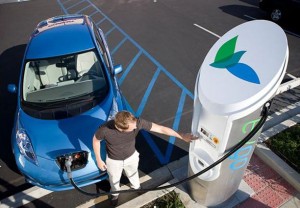 Back in 2000, rolling blackouts descended upon California and eventually cost Governor Gray Davis his job. The crisis was caused by deviant corporate behavior, and one of the companies involved, NRG, finally settled with the state in 2012 for damages related to its conduct. But instead of being punished, the California Public Utilities Commission allowed NRG to commit to spending $100 million on electric vehicle public charging infrastructure, essentially helping the company invest in a new business venture.
Back in 2000, rolling blackouts descended upon California and eventually cost Governor Gray Davis his job. The crisis was caused by deviant corporate behavior, and one of the companies involved, NRG, finally settled with the state in 2012 for damages related to its conduct. But instead of being punished, the California Public Utilities Commission allowed NRG to commit to spending $100 million on electric vehicle public charging infrastructure, essentially helping the company invest in a new business venture.
It was a controversial bargain, but the upshot for the state was a big injection of capital into badly needed electric vehicle infrastructure. With 65,000 electric vehicles now on the road in California, the competition is increasing for charging stations. The NRG settlement would result in at least 200 new publicly available fast-charging stations around the state, as well as wiring for 10,000 more charging stations in offices, homes, and other public and private spaces.
So how is implementation going? Not well. NRG’s new subsidiary to build these stations, eVgo, is way behind schedule, with only 13 fast-charging stations open out of the 200 that need to be ready by 2016, with 100 of those to be open by the end of this year under the settlement terms. The company cites the startup pains associated with trying to get new infrastructure built – finding amenable site hosts, upgrading local utility wiring and equipment, and clearing the necessary permits. They believe they will make up for lost time this year.
But much of the reason for the delay is the basic conflict of interest involved in this settlement, which allows eVgo to site charging stations in crowded, complicated, and suboptimal urban areas in order to maximize the company’s profits. To be truly effective, expensive fast-charging stations (which can repower a battery to 80% capacity in just 20 minutes) should instead be located between cities and popular destinations, replicating the interstate gas stations drivers rely on for longer trips. These sites allow drivers to extend the range of their all-battery vehicles when they’re driving between cities like San Francisco and Sacramento, Los Angeles and San Diego/Palm Springs/Santa Barbara, or Fresno to Bakersfield, to name a few. For a good example of successful (and speedy) fast-charger deployment, look no further than Tesla and its optimally located Supercharger network along well-traveled interstates (enabling even an all-electric cross-country road trip).
On the other hand, fast-charging stations in urban areas tend to be a waste of money and counter-productive. Most city visitors live or work within 20 or 30 miles, meaning that a full charge over a regular wall outlet at the home or office should be sufficient to get them into the city and back in a typical 85 mile-range electric vehicle. And if they do need to charge downtown, these drivers usually don’t need a 20 minute fast charge because they are there to work or shop for at least one or two hours anyway. For this time frame, a cheaper “Level 2” 240V station will do just fine. What’s worse, crowded downtown fast chargers often require drivers to wait in line, defeating the purpose of a “fast” charge.
So why doesn’t eVgo/NRG follow this more sensible interstate model instead of trying to site their stations in suboptimal urban areas? Part of the answer lies in the settlement, which prescribes regions of the state for deployment. But the larger problem is that the company has a business interest in trying to make money off these stations through repeat customer membership deals and from patronage at nearby retail options. That’s why the company is working with upscale businesses, like Whole Foods and Urban Outfitters, and selling membership deals to hook local drivers into subscribing and becoming captive customers who will shop near the stations. This is a waste of charging infrastructure and a probable money-loser for NRG to boot.
If California was serious about making NRG pay for its rolling blackout damages and truly benefitting electric vehicle drivers, state leaders would insist that the fast-charging stations go in interstate locations, a la Tesla, to facilitate extended range for all-battery electric vehicle drivers. These locations should be the first priority, and they should blanket the state between our cities, not within them, and certainly not next to the local Whole Foods.
Were NRG representatives to take that approach, they’d find it a lot simpler to get these stations installed and ready. Sure, it wouldn’t help the company’s bottom line as much, but it would best serve the electric vehicle drivers of California.

